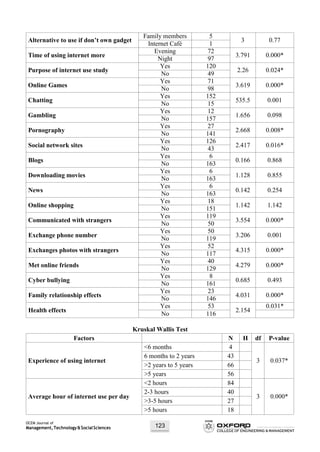This document provides an abstract for a study examining the consequences of mother international migration on the education, health, and psychosocial development of left behind girls under age 16 in Chitwan District, Nepal. A mixed methods approach was used, collecting data through surveys and interviews. The results showed that mother international migration was positively related to feelings of loneliness, poor health, negative neighbor attitudes, relationship problems, and an unsupportive home environment. It was negatively related to social attachment, outdoor activities, positive feelings, family support, and access to food. About 80% of interviewees felt their development was affected, and 60% felt it was negatively affected. The qualitative findings supported and provided additional context for the quantitative results. The implication
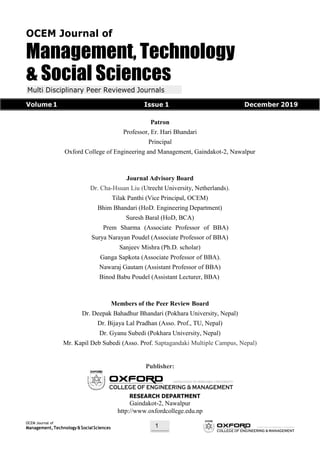









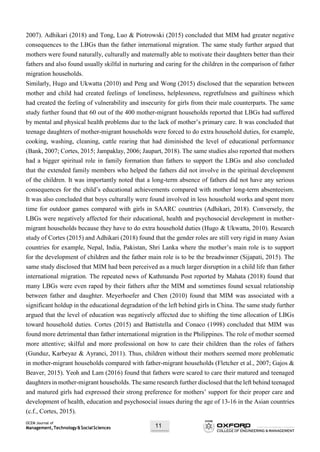



![OCEM Journal of
Management,Technology&SocialSciences 15
summary Table shows the values of -2Log Likehood (232.205), Cox and Snell R2
and Nagelkerke R2
[25.60 % (Cox and Snell) and 35.20 % (Nagelkerke)] variance of the model was explained by the
independent variables. Hosmer and Lemeshow Test shows that p = 0.280 > 0.05 is insignificant which
was good to support for the regression model fit. The classification Table shows that out of 104 LBGs who
chose the first option they were affected by their MIM, this model predicts 29 LBGs were not affected
for their education, health and psychosocial development after their MIM. Again, out of 109 LBGs who
chose the second option that they were not affected by their mother out migration, 30 of them were found
affected by their MIM. Thus, this model predicts the impact of MIM to the LBGs on education, health
and psychosocial development with 71.4 percent accuracy for those who said they were affected and also
predicts 73.1 percent of accuracy of prediction for the LBGs who chose the second option that they were
not affected by their MIM.
The results further confirmed that the overall percentage of correctness of observed data was 72.3 %.
The results also show that there was significant association between the use of social media and outdoor
activities, sound psychosocial feeling and family support to LBGs and MIM (p < 0.05 with odds ratio
1.780, 2.459, 1.972) (see in the Table 3). Again, when the independent variable the use of social media
and outdoor activities increases one unit, the impact of MIM can be predicated to increase around 1.780
times if other variables are controlled signifying that the use of social media and outdoor activities has
positive impact on education, health and psychosocial development of the LBGs after their MIM (Odd
ratio = 1.780 > 1, B = 0.576 > 0). The current study has supported the previous finding of Dhar (2012)
because the previous and the current studies have found that there was positive correlation between using
social media and the education, health and psychosocial development of the LBGs.
Similarly, when the independent variable sound psychosocial feeling increases one unit, the impact of
MIM can be predicated to increase around 1.972 times if other variables are controlled signifying that
psychosocial feeling has positive impact on education, health and psychosocial development of LBGs
after their MIM (Odd ratio = 2.459 > 1, B=.0.900 > 0). Again, when the independent variable family
support increases one unit, the impact of MIM can be predicated to increase around 2.459 times if other
variables are controlled signifying that family support has positive impact on education, health and
psychosocial development after MIM (Odd ratio = 1.972, B = 0.679 > 0). This study has also supported
the study of Jensen, Giorguli Saucedo & Hernández Padilla (2018) because the previous and the current
studies have found that family support to the LBGs has positively correlated for the education, health and
psychosocial development of the LBGs.
4.3 Results on categorical variables of the Linear Regression Model
The categorical variables on the ages of the LBGs and their mothers’ feeling were entered the Linear
Regression Model of the SPSS to find the correlation between them.
Table 4. The correlation between categorical variables and
the remembrance of mothers by the LBGs
a. Predictors: (Constant), Fifteen to sixteen years, fourteen to fifteen years
b. Dependent Variable: QNo15 Do you remember your mum now?
Model R R Square Adjusted R Square Std. Error of the Estimate Durbin-Watson
1 .173a
.030 .021 .435 2.036](https://image.slidesharecdn.com/finaljournal-201117003412/85/Dr-Basanta-Adhikari-15-320.jpg)

![OCEM Journal of
Management,Technology&SocialSciences 17
6. Discussion & Conclusion
This study was conducted at Chitwan District to examine both positive and negative consequences of
MIM to the LBGs for their education, health and psychosocial development among the mother migrant
households. The MIM and its consequences on the LBGs is a very debatable issue for the women and
gender study in the Asian context. The empirical research reveals that there was both negative and
positive consequences of MIM to the LBGs for their education, health and psychosocial development
in MIM households. A mixed method research approach was applied to collect data. Two hundred and
thirty-seven LBGs were involved in the survey study and six LGBs as interviewees were involved in the
qualitative study. There were twenty-two subscales with the values of mean, SD and Cronbach’s Alpha
(see in the Table 1) and also twenty-two independent variables in this study. The results indicate that there
were twelve significant indicators for the consequences of MIM (p < 0. 05) [see in the table 23]. The
results show that there was significant association between the consequences of MIM and the use of social
media and outdoor activities, positive psychosocial feeling and family support (p< 0.05 with odds ratio
1.780, 2.459, 1.972) in the Wholesome Model of Binary Logistic Regression Analysis. The implication
of the study is to support local government to formulate the child friendly policy and make aware the
local government to protect child rights in Chitwan District. The findings of the current study can be
generalized in the same context of larger population because of the larger quantitative sample population
involvement in this study. The results further conclude that the linear regression model was the statistical
significance where, p < 0.038, which is less than 0.05, indicating that, overall, the regression model
statistically significantly predicts the outcome variables which is a good fit for the data. The development
of the left behind girls under the age of 16 on education, health and psychosocial development is a globally
debatable issue so that researchers, academicians, police officers, policy makers and the government have
to focus on their future research for the children rights, security, safety and their overall development.
The universe is based on variation on mankind, geographical structure, population, resources, political
system, form and nature of governments so that there are the variations in the condition of the LBGS
among each country. Nepal is an underdeveloped country where the condition of the LBGs is adverse and
unfavourable for their overall development. The issue of the MIM and its negative consequences have to
be addressed in the future research of the international researchers and academic institutions. This study
is the ongoing research phenomenon to collect he larger scale of and analyzing holistically in future. It
is estimated that two thousand respondents for the survey study, fifty-one interviews for the qualitative
study and five Focus Group Discussion have been targeted to complete the study in future. The doctors,
police officers, immediate parents, the LBGs between the aged of 10 to 16 years, compounders, doctors
and social workers will be focused to collect qualitative data and quantitative data to enlarge this study.
References
Adhikari, B. (2018). The negative impacts of MIM to the left behind girls to the left behind girls under 16
years old on education, health and psychosocial development in Chitwan District. Retrieved from
https://www.researchgate.net/search.
Adhikari, J. (2006). Nepali women and foreign labour migration (1st Ed.). Kathmandu: UNIFEM.
Agbola, F., & Acupan, A. (2010). An empirical analysis of international labour migration in the
Philippines. Economic Systems, 34(4), 386-396.](https://image.slidesharecdn.com/finaljournal-201117003412/85/Dr-Basanta-Adhikari-17-320.jpg)







![OCEM Journal of
Management,Technology&SocialSciences 25
7
6 1
259, [PERCENTAGE]
54, [PERCENTAGE] 2
1
5
801, [PERCENTAGE]
352, [PERCENTAGE] 3
4
4
410, [PERCENTAGE]
2
3 606, [PERCENTAGE] 5
506, [PERCENTAGE]
6
Gamifying learning experiences:
Practical implications and outcomes
Current status, opportunities and
challenges of augmented reality in
education
Flipping the classroom and
instructional technology integration in
a college-level information
Technological pedagogical content
knowledge –areviewoftheliterature
Assessing the effects of gamification
in the classroom
Puttingtwittertothetest:Assessing
outcomesforstudentcollaboration,
engagement andsuccess
based on per five selected journals and per year among the five selected journals. The results section
further explores the details analysis of 7 highly cited articles based on the publication years, citation
counts and the percentage covered by each article in each Pie-chart. The fourth part of the current
dissertation introduces the summary and conclusion of the whole part of this study which also compares,
contrasts and synthesizes the key findings of the results section. The purpose of the current research
design was to analyze the most cited seven articles per five selected journals and per year among the
five selected journals between 2013 to 2017. The contents for the analysis are years of publication and
citation counts of the most cited seven published articles among forty one published papers. First of all,
five journals entitled the CE, CAL, BJET, IEEE TLT and JETRD were selected. The number of citation
counts might be more in the forthcoming day, but the current researcher does not consider the citation
counts after 20th
May 2018. In the current study, the research topics of each published article have been
embedded in different subjects and different areas of the educational and technology research (see in the
Appendix 1 and 2). Twenty-five most cited published papers were derived from per five selected journals.
Similarly, another twenty-five most cited published papers per year among five selected journals between
2013 to 2017 were selected. The selected articles mentioned in the Table 1 and 2 are embedded in the total
citation counts of each published article, published years and the name of five selected journals. There
are five rows and five columns in the Table 1 and 2 where forty-one published articles are mentioned as
well. Only the fortyone published articles are mentioned in the Table 1 and 2.
3. Results
3.1 Analysis of Seven the Most Cited Articles among Horty one highly Cited articles
The seven the most cited articles among the forty-one the most cited published articles according to per
five selected journals and per year five selected journals were selected for the further analysis but other
most cited articles were excluded in the analysis The analysis has mainly focused on the citation counts,
published years and the five selected journals among fourty one most cited published articles.
Detailed analysis of the seven most cited published articles per journal and per year
Figure 1. Seven most cited published articles among five selected journals](https://image.slidesharecdn.com/finaljournal-201117003412/85/Dr-Basanta-Adhikari-25-320.jpg)


![OCEMJournalof
Management,Technology&SocialSciences28
to review them separately so that it can help the future researchers to know the special issues of each
journal and to conduct primary research on different issues, for example, BJET, CE, JCAL, IEEE TLT,
JETRD. It is also recommended that the future research has to focus on different characteristics (for
example, strengths and weakness, contents, abstracts, citation counts, published years). Finally, in order
to generalize the results obtained in this study, similar analysis of the most cited articles per five journals
and per year among the five selected journals should be made on reviewing most cited published articles
between 2013 to 2017.
References
Abramovich, S., Schunn, C. and Higashi, R. (2013). Are badges useful in education? It depends upon
the type of badge and expertise of learner. Educational Technology Research and Development,
61(2), 217-232.
Aksnes, D. (2003). Characteristics of most cited articles. Research Evaluation, 12(3), 159-170.
Arteaga Sánchez, R., Cortijo, V. and Javed, U. (2014). Students’ perceptions of Facebook for academic
purposes. Computers & Education, 70, pp.138-149.
Buckley, P.and Doyle, E. (2017). Individualising gamification: An investigation of the impact of learning
styles and personality traits on the efficacy of gamification using a prediction market. Computers
& Education, 106(1), 43-55.
Creswell, J. (2017). Designing & Conducting Mixed Methods Research + The Mixed Methods Reader.
[S.L.]: Sage Publications.
Dalby, D., & Swan, M. (2018). Using digital technology to enhance formative assessment in mathematics
classrooms. British Journal of Educational Technology. doi: 10.1111/bjet.12606Daldrup-
Davies, R., Dean, D. and Ball, N. (2013). Flipping the classroom and instructional technology integration
in a college-level information systems spreadsheet course. Educational Technology Research and
Development, 61(4), pp.563-580.
De Witte, K., Haelermans, C., & Rogge, N. (2014). The effectiveness of a computer-assisted math learning
program. Journal of Computer Assisted Learning, 31(4), 314-329.
Innovation in technologies for educational computing. (2016). IEEE Transactions on Learning
Technologies, 9(1), 96-96.
Januszewski, A. (2001). Educational technology. Englewood, Colo.: Libraries Unlimited.
Lee, M., Wu, Y., & Tsai, C. (2009). Research Trends in Science Education from 2003 to 2007: A content
analysis of publications in selected journals. International Journal of Science Education, 31(15),
1999-2020.
Margaryan, A., Bianco, M. and Littlejohn, A. (2015). Instructional quality of Massive Open Online
Courses (MOOCs). Computers & Education, 80, pp.77-83.
Onifade, A. (2011). The third millennium secretary and information & communication technology:
Nigerian experience. International Journal of Management & Information Systems (IJMIS), 13(2),
39.
Pathek, R., & Chaudhay, J. (2012). Educational technology. New Delhi: Dorling Kindersley.](https://image.slidesharecdn.com/finaljournal-201117003412/85/Dr-Basanta-Adhikari-28-320.jpg)













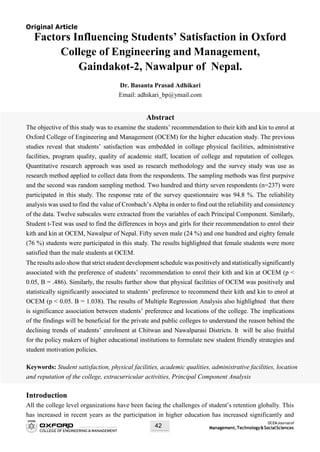



![OCEMJournalof
Management,Technology&SocialSciences46
3. Methods
To answer the research questions mentioned in the section 2, a large-scale survey study was conducted
in OCEM Gaindakot-2, Nawalpur. OCEM instead of the whole colleges of Nawalpur was chosen as
the collage of investigation as the authority for students’ preference to recommend their kith and kin
with the regional college not with the national colleges. Given the fact, reginal facilities on academic,
managerial, psychical and infrastructure condition differ and that these differences might influence
students’ preferences to recommend their kith and kin, I opted to include only Signal College(OCEM).
3.1 Sample
Given the differences in enrolment, duration of the study and orientation of the aforementioned students
satisfaction for academic, managerial, psychical and infrastructure facilities, I opted to investigate
students experiences, satisfaction and preference for the recommendation to their kith and kin in a signal
program (BBA). As the majority of the students enrolled in four years (BBA program affiliated with
Pokhara University), I conducted my study in this program.
For the purpose of the current study, it was necessary to reach both students who have just commenced
their BBA and those students who already completed their BBA at OCEM. All the students from different
semesters were invited to participate in the study by providing contact information on students who had
successfully completed their BBA from OCEM. In total students of eight different semesters agreed to
participate in the study. Enrollment in these semesters was 35 to 40 students in each semester. Participants
per semester (first, second, third, fourth, fifth, sixth, seventh and eighth) ranged 30 to 45 students. Out of
two hundred and thirteen respondents, fifty seven (n=57) respondent was male and one hundred and eighty
(n=180) respondents was female. The response rate of the survey instrument was 94.8 % [237/250x100].
The Cronbach’s Alpha was computed to check the reliability of the data (see in the Table2).
3.2 Instruments
Information on the personal variables gender, location of the college, family monthly incomes of the
students and religions was obtained through the student administration of the participating collage
(OCEM). To gain insight into students’ satisfaction and preference for existing students and graduated
students, the seven questionnaires were developed. Existing literature was reviewed for students;’
satisfaction and preference to recommend their kith and kin. To design the instrument as broadly as
possible, no single model or theoretical framework (students satisfaction, expectations, perceive quality,
student loyalty) was used as reference. Instead all possible motives were inventoried. The resulting
instrument was piloted with tem graduated BBA students who did not study anymore to check our face-
validity and possible missing motives of students. For each motive, respondents had to indicate on a five-
point scale whether the reason had ranged from completely disagreed to completely agree.
3.3. Analysis
Previous study has sometimes relied heavily on single-item indicators of students’ satisfaction and
preference or raw frequency counts of motives. This approach maximizes the possibility of measurement
error (e.g. Watt &Richardson, 2007). To construct this caveat, I choose to work with more encompassing](https://image.slidesharecdn.com/finaljournal-201117003412/85/Dr-Basanta-Adhikari-46-320.jpg)
![OCEM Journal of
Management,Technology&SocialSciences 47
constructs, measured by multiple items. To identify these underlying themes in my questionnaire, a
Principal Component Analysis (PCA) was run. Subsequently, an Exploratory Factor Analysis (EFA) with
Varimax rotation was carried out to refine and interpret these components. Eigenvalues, the scree plot and
theoretical interpretability were used to make a decision on the number of factors. A factor loading of at
least [0.40] was taken as cut-off point to incorporate a specific item as an indicator for an understanding
motive. To explore the relation between students’ preference and personal variables (RQ1), descriptive
statistics and cross tabulations were computed. Descriptive statistics were also computed to analyze
students’ motives (preferences) for the recommendation to enroll at OCEM (RQ2). To explore the effect
of having actual college’s facilities experience after graduation on preference for the recommendation
after controlling for gender and different college locations, family income levels and different religions
of the students (RQ3), a stepwise strategy was followed. First a Binary Logistic Regression Model was
computed to assess the impact of the predictor and control variables on all motives. Both significant
levels and effective sizes were considered using Cohen’s d cut-off points (Cohen, 1998). The next, the
Chi-square Test and Student t-Test was computed to examine the association between two variables
measured on categorical scales (Pandya, Bulsari & Sinha, 2018).
4. Results
4.1. Preliminary analyses: subscales with mean, SD, reliabilities and p values
Mean calculation was carried out for an analysis tool because all the variables are in the normal
distributions and also variables are in order. Again, the distribution of variables has been well studied and
is well understood (e.g. normally distributed). The data analysis was carried out to compare the values of
mean, SD, Cronbach’s Alpha and p values of the twelve subscales. The subscales were categorized into
three groups which is 2.00 to 2.50 as the first group, 2.50 to 3.00 as the second group and 3.00 to 3.50 as
the third group respectively (see in the Table 2).
Table 2. Descriptive statistical analysis on academic factors on student’s satisfaction (N=237).
Scales Mean SD Cronbach's Alpha p values
Classroom facilities 2.04 0.64 0.71 .594
Faculty support for maintaining quality 2.13 0.82 0.75 .031
Technological facilities 2.29 0.75 0.70 .049
Physical facilities 2.32 0.74 0.70 .163
Emphasis on punctuality 2.35 .81 0.71 .396
Health and safety issues 2.43 0.91 0.70 .656
Using technologyin teaching and learning activities 2.47 0.77 0.72 .603
Emphasis on quality of extracurricular activities 2.58 0.69 0.73 .881
Strict nature of principal 2.81 1.11 0.80 .001
Strict students' career development schedule 2.92 0.90 0.71 .927
Availability of teaching resources 3.12 1.33 0.81 .794
Canteen services 3.33 1.20 0.80 .026
The mean value of the first subscale “classroom facilities” had been calculated as 2.04 signifying that
students were disagreed with the statements that they had sufficient furniture, the class room were well](https://image.slidesharecdn.com/finaljournal-201117003412/85/Dr-Basanta-Adhikari-47-320.jpg)

![OCEM Journal of
Management,Technology&SocialSciences 49
4.2. Relationship between students’ preference personal variable gender
The first H1
assumes equal variances and the second H2
does not. The Levene’s test decides which
version of the t-test to report. If the Levene’s test shows no significance violations of the assumption, we
should report the “equal variances assumed” version of the t-test. Conversely, if the Levene’s test shows
significance violations of the assumption, we should report the “not equal variances assumed” version
of the t-test (Pandya et al., 2018). I have set the null and alternative hypotheses for Levene’s Test for
equality of variances are as follows.
H1
: Variances of two groups are equal.
H2
: Variances of two groups are not equal.
The mean score of the male students of the first subscale classroom facilities (M = 2.04, SD = 0.75)
is not statistically significantly differ [t (235) = 0.446, p = 0.594] than that of the female students on
the same variable (M = 2.00, SD = 0.61). Similarly, the mean score of the male students of the second
subscale faculty support for maintaining quality (M = 2.33, SD = 0.90) is statistically significantly higher
[t (91.54) = 2.165, p = 0.031, Cohen’s d = 0.31] than that of the female students on the same variable (M
= 2.07, SD = 0.77), signifying that male students had higher preference to recommend their kith and kin
to enroll at OCEM which is minimums effect.. Again, the mean score of the male students of the third
subscale technological facilities (M = 3.28, SD = 1.22) is statistically significantly higher [t (91.54) =
3.425, p = 0.001 than that of the female students on the same variable (M = 2.66, SD = 1.03, Cohen’s d
= 0.31) signifying that male students had seen more happy for the recommendation their kith and kin to
join at OCEM which has medium effect on it. Similarly, the mean score of the male students of the fourth
subscale physical facilities (M = 2.43, SD = 0.88) is not statistically significantly differ [t (235) = -1.398,
p = 0.163)] than that of the female students on the same variable (M = 2.28, SD = 0.67). Again, the mean
score of the male students of the fifth subscale emphasis on punctuality (M = 2.43, SD = 0.84) is not
statistically significantly differ [t (235) = 0.851, p = 0.396] than that of the female students on the same
variable (M = 2.32, SD = .81). Again, the mean score of the male students of the sixth subscale health
facilities (M = 2.64, SD = 0.97) is statistically significantly lower [t (86.67) = 1.171, p = 0.04, Cohen’s
d = 0.29] than that of the female students on the same variable (M = 2.37, SD = 0.87), signifying that
female students had higher preference to recommend their kith and kin to enroll at OCEM. Similarly,
the mean score of the male students of the seventh subscale using technology in teaching and learning
activities (M = 2.91, SD = 0.96) is not statistically significantly differ [t (235) =, p = 0.603) than that of
the female students on the same variable (M = 2.92, SD = 0.89).
Again, the mean score of the male students of the eighth subscale emphasis on quality of extracurricular
activities (M = 2.59, SD = 0.68) is not statistically significantly differ [t (235) = 0.150, p = 0.881] than
that of the female students on the same variable (M = 2.58, SD = .70). Again, the mean score of the male
students of the ninth subscale strict nature of principal (M = 3.28, SD = 1.22) is statistically significantly
higher [t (82.94) = 3.428, p = 0.001, Cohen’s d = 0.54] than that of the female students on the same
variable (M = 2.66, SD = 1.03), signifying that male students had higher preference to recommend
their kith and kin to enroll at OCEM which is minimum effect. Furthermore, the mean score of the male
students of the tenth subscale strict students’ career development (M = 2.91, SD = 0.96) is not statistically
significantly differ [t (235) = -.092, p = 0.927] than that of the female students on the same variable (M](https://image.slidesharecdn.com/finaljournal-201117003412/85/Dr-Basanta-Adhikari-49-320.jpg)
![OCEMJournalof
Management,Technology&SocialSciences50
= 2.92, SD = 0.89). Similarly, the mean score of the male students of the eleventh subscale availability
of teaching resources (M = 3.07, SD = 1.22) is not statistically significantly differ [t (234) = 0.262, p =
0.794] than that of the female students on the same variable (M = 3.07, SD = 1.37). Finally, the mean
score of the male students of the twelvelth subscale canteen facilities (M = 3.00, SD = 1.13) is statistically
significantly lower [t (235) = -.092, p = 0.927, Cohen’s d = -.0. 37] than that of the female students on
the same variable (M = 3.44, SD = 1.21), signifying that female students’ preference to recommend their
kith and kin to enroll l at OCEM which is minimum effect.
4.3. Results of Chi-square Test
Chi-square Test was carried out to examine the association or statistical independence between two or more
variables measured on categorical scales. The null and alternative hypotheses for Chi-square test bare:
H0
: There is no association between the row (Gender) and column (Students’ preference to enroll l at
OCEM).
H1
: There is association between the row (Gender) and column (Students’ preference to enroll l at OCEM).
Table 4. Chi-Square Test between gender and students’ preference to
recommend for the admission at OCEM.
Count: Do you recommend your kith and kin to join at OCEM to study?
Gender
Options 1=Yes 2= No
Yeah No Total
Male 36 21 57
Female 153 27 180
Total 189 48 237
Crosstabulation of gender and options of the students’ preference of recommendation to their kith and kin
to join at OCEM shows that out of 57 male students, 36 intended to recommend their kith and kin and
21 did not intend to recommend their kith and kin to enroll at OCEM. Again, out of 180 female students,
153 intended to recommend their kith and kin to study at OCEM and 27 female students did not intend to
recommend their kith and kin to study at OCEM. This shows that there is association between gender and
students’preference for recommendation for the enrollment at the college where they are studying now.
Table 5. Chi-Square table of gander and students’ recommendation preference
Particulars Value df
Asymptotic Signifi-
cance (2-sided)
Exact Sig.
(2-sided)
Exact Sig.
(1-sided)
Pearson Chi-Square 12.787a
1 .000
Continuity Correction 11.471 1 .001
Likelihood Ratio 11.645 1 .001
Fisher's Exact Test .001 .001
Linear-by-Linear Association 12.733 1 .000
N of Valid Cases 237
The table 4 provides that the value of Chi-Square is11.471 and associated significance value is 0.001<0.05.
Therefore, the hull hypothesis is rejected, and signifying that there is association between the gender and
students’ preference to recommend their kith and kin to study at OCEM.](https://image.slidesharecdn.com/finaljournal-201117003412/85/Dr-Basanta-Adhikari-50-320.jpg)

![OCEMJournalof
Management,Technology&SocialSciences52
Table 8 Significant indicators of Binary Logistic Regression Wholesome Model
Variables in the equation (n = 237)
Independent variables B S.E Wald df Sig Exp(B)
95% C.I.for EXP(B)
Lower Upper
Emphasis on quality of extracurricular -.220 .324 .462 1 ..497 .802 .425 1.515
Strict student development schedule .486 .241 4.052 1 .044 1.625 1.013 2.607
Better teaching environment .510 .292 3.046 1 .081 1.664 .939 2.950
Strict nature of principal .239 .194 1.525 1 .217 1.271 ..869 1.858
Emphasis on punctuality -.305 .286 1.138 1 .286 .737 .421 1.290
Requirement of high quality .177 .255 .480 1 .488 1.193 .724 1.968
Physical facilities 1.038 .377 9.482 1 .002 2.822 1.458 5.463
Teaching resources .074 .166 .202 1 .653 1.077 .779 1.490
Health issue .260 .249 1.088 1 .297 1.297 .796 2.115
Consent 1.785 .228 61.361 1 .000 .001
The Omnibus Tests [Chi-Square = 50.404, df = 9, p =.001] and associated significance level is less
than 0.05, the present model shows a decrease in deviance from the base model because Chi-Square
is positive, showing this model is better fit compared the base model. The model summary table
shows the values of -2Log Likehood (187.987), Cox and Snell R2
and Nagelkerke R2
[19.20 % (Cox
and Snell) and 30.20 % (Nagelkerke)] variance of the model was explained by the independent
variables. Hosmer and Lemeshow Test shows that p = 0.054 > 0.05 is insignificant which is good
to support for the regression model fit. The classification Table shows that out of 212 students who
showed their preference to recommend their kith and kin to join at OCEM, this model predicts 181
students intended to recommend their kith and kin to join at OCEM but 31 students intended not
to recommend their kith and kin to join at OCEM. The classification Table further shows that out
of 24 students who did not intent to preference to recommend their kith and kin to join at OCEM,
17 of them intended to recommend their kith and kin to join at OCEM. Thus, it predicts students
who intended to recommend their kith and kin to join at OCEM with 96.3 percent accuracy and also
predicts that students who did not intend to recommend their kith and kin to join at OCEM with 35.4
percent accuracy.
The results further show that the overall percentage of correctness of observed data was 83.9 %. The
results also show that there was association between students’ preference to recommend to their kith
and kin to enroll at OCEM and strict schedule of student development (p< 0.05 with odds ratio 1.625,
B = .486 >1) in the Wholesome Analysis of Binary Logistic Regression Model indicating the positive
impact on the schedule of the internal examination, grooming the student’s career path and availability
of interactive learning environment at OCEM. Similarly, the results further indicate that there was
significant association between the student recommendation to their kith and kin to enroll l at OCEM
and physical facilities of OCEM (p< 0.05 with odds ratio 2.822, B = 1.038) in the Wholesome Analysis
of Binary Logistic Regression Model indicating the positive impact on the availability of books at the
library and the comfortable transport system, management of the hygienic canteen and the management
of the better lab facilities (see in the Table 8).](https://image.slidesharecdn.com/finaljournal-201117003412/85/Dr-Basanta-Adhikari-52-320.jpg)

![OCEMJournalof
Management,Technology&SocialSciences54
5. Discussion & Conclusion
The purpose of the current study was to examine the students’ preference to recommend their kith and
kin to enrol and to continue their higher degree at OCEM for the further study. The quantitative research
approach along with the survey method was used to examine the opinions, experiences and ideas of
students on their preference to recommend and to continue their further education at OCEM. The study
was conducted inside the OCEM premises which had followed full criteria of research ethics. This study
had clearly defined purpose and common concepts. The research procedure was described in sufficient
detail to permit another research to repeat the research for further advancement, keeping the continuity
of what has already been attained, reported with complete frankness, clear flaws in procedural design and
has estimated the effects of all issues mentioned earlier paragraph upon the findings. The data analysis
was adequate to reveal its significance and the methods of analysis was appropriate, the validity and
reliability of the data were checked with the minimum value of Cronbach’s Alpha (0.60) and the research
design was carefully planned to yield results that were as objectives as possible. The Factor Reduction
Model of Principal Component Analysis was used to find the relationship among different variables of
each instrument.
The data analysis was based on descriptive statistics model where mean, Standard Deviation, Independent
Sample t-Test of two different groups and Chi-Square Test were computed to find the association
between gender and students’ preference to recommend and to continue student’s preference for the
further education at OCEM. The Binary Logistic Regression of PCA was applied to find the association
between the dependent and independent variables. The results show that there is significant relationship
between emphasis on quality of extracurricular activities, strict student development schedule, better
teaching environment, nature of principal, emphasis on punctuality, requirement of high quality, physical
facilities, teaching resources and health and safety issues (p<0.05, B = -.500. -.449, -.429, -.490, -.404,
-.428, -.904, -.410, -.295 and -.931) respectively. This study reveals that there was association between
students’ preference to recommend to their kith and kin to join at OCEM and strict student career
development schedule (p< 0.05 with odds ratio 1.625, B = .486) in the Wholesome Analysis of Binary
Logistic Regression Model indicating the positive impact on the schedule of the internal examination,
grooming the student’s career path and availability of interactive learning environment at OCEM.
Similarly, the results further confirm that there was significant association between the male and female
for the recommendation to their kith and kin to join at OCEM and physical facilities of OCEM (p< 0.05
with odds ratio 2.822, B = 1.038) in the Wholesome Analysis of Binary Logistic Regression Model
indicating the positive impact on the availability of books for the study and the comfortable transport
system, management of the hygienic canteen and management of the better lab facilities. The implication
of this study would be useful for the college administration to formulate new student admission strategies
and to reform different internal student centered policies.
Acknowledgement
The author thanks all the Department Heads, lecturers and students of Oxford College of Engineering
and Management [OCEM] Gaindakot-2 Nawalpur of Nepal who made substantial contributions to this
work. This work was fully funded by the OCEM. The supporting roles and contributions of Professor](https://image.slidesharecdn.com/finaljournal-201117003412/85/Dr-Basanta-Adhikari-54-320.jpg)
![OCEM Journal of
Management,Technology&SocialSciences 55
Er. Hari Bhandari to complete this great work was very much admirable and appreciative. Ms. Rabina
Lamichhane Magar, Shashikala Sapkota & Sushmita Chaudhary are highly appreciated for their great
contribution of data collection during this study.
References
Adhikari, B. (2016). The Gender Discrimination in Childhood Education in Nepal. [Online] Academia.
Available at: https://www.academia.edu/26193972 [Accessed 16 Jun. 2019].
Alves, H. and Raposo, M. (2010). The influence of university image on student behaviour. International
Journal of Educational Management, 24(1), 73-85.
Bassi, F. (2019). Students’ satisfaction in higher education: the role of practices, needs and beliefs of
teachers. Quality Assurance in Education, 27(1), 56-69.
Bini, M. and Masserini, L. (2015). Students’ Satisfaction and Teaching Efficiency of University
Offer. Social Indicators Research, 129 (2), 847-862.
Cassel, C. and Eklöf, J. (2001). Modelling customer satisfaction and loyalty on aggregate levels:
Experience from the ECSI pilot study. Total Quality Management, 12(7-8), 834-841.
Chen, Y.C. (2014) “An empirical examination of factors affecting college students’ proactive stickiness
with a web-based English learning environment,” Computers in Human Behavior; 31: 1,159-171
Cohen, L., Manion, L. and Morrison, K. (2011). Research methods in education. London: Routledge.
Coskun, L. (2014). Investigating the Essential Factors on Student Satisfaction:ACase ofAlbanian Private
University. Journal of Educational and Social Research.
Douglas, J., Douglas, A., & Barnes, B. (2006). Measuring student satisfaction at a UK university. Quality
Assurance in Education, 14(3), 251–267.
Elliott, K. and Healy, M. (2001). Key Factors Influencing Student Satisfaction Related to Recruitment
and Retention. Journal of Marketing for Higher Education, 10(4), 1-11.
Farahmandian, S. (2013). Perceived service quality and student satisfaction in higher education. IOSR
Journal of Business and Management, 12(4), 65-74.
García-Aracil, A. (2008). European graduates’ level of satisfaction with higher education. Higher
Education, 57(1), pp.1-21.
Gibson, A. (2010). Measuring business student satisfaction: A review and summary of major predictors.
Journal of Higher Education Policy and Management, 32(3), 251-59
Hanssen, T. and Solvoll, G. (2015). The importance of university facilities for student satisfaction at a
Norwegian University. Facilities, 33(13/14), 744-759.
Hernadewita et al., H. (2019). PLS-SEM Based Analysis of Service of Learning, Service Quality and
Satisfaction of College Student in Polytechnic. International Journal of Mechanical and Production
Engineering Research and Development, 9(3), 861-870.
Insch, A. and Sun, B. (2013). University students’ needs and satisfaction with their host city. Journal of
Place Management and Development, 6(3), 178-191.
Kärnä, S. and Julin, P. (2015). A framework for measuring student and staff satisfaction with university
campus facilities. Quality Assurance in Education, 23(1), 47-66.](https://image.slidesharecdn.com/finaljournal-201117003412/85/Dr-Basanta-Adhikari-55-320.jpg)
![OCEMJournalof
Management,Technology&SocialSciences56
Kärnä, S. and Julin, P. (2015). A framework for measuring student and staff satisfaction with university
campus facilities. Quality Assurance in Education, 23(1), 47-66.
Kreber, C. (2009).Academics’teacher identities, authenticity and pedagogy. Studies in Higher Education,
35(2), 171-194.
Langstrand, J., Cronemyr, P. and Poksinska, B. (2014). Practise what you preach: quality of education
in education on quality. Total Quality Management & Business Excellence, 26(11-12), 1202-1212.
Mihanović, Z., Batinić, A. and Pavičić, J. (2016). The link between students’ satisfaction with faculty,
overall students’ satisfaction with student life and student performances. Review of Innovation and
Competitiveness, 2(1), 37-60.
Mukhtar, U., Ahmed, U., Anwar, S. and Baloch, M.A. (2015). “Factors affecting the service quality of
public and private sector universities comparatively: an empirical investigation; Journal of Arts,
Science & Commerce; 3(1), 132-142.
Nogueira, M. (2018). Measuring Academic Life Satisfaction in Portuguese Students. Nursing &
Healthcare International Journal, 2(1).
Pandya, K., Bulsari, S. and Sinha, S. (2018). SPSS in simple steps. New Delhi: Dreamteach, 1-179.
Quality Improvement Based on a Process Management Approach, with a Focus on University Student
Satisfaction. (2016). Acta Polytechnic a Hungarica, 13(6). http://dx.doi.org/10.12700.
Sweeney, L (2016). A Predictive Model of Student Satisfaction,” Irish Journal of Academic Practice:
5(1), 1-31 (https://arrow.dit.ie/ijap/vol5/iss1/8)
Tucker, B. (2013). Student evaluation to improve the student learning experience: anAustralian university
case study. Educational Research and Evaluation, 19(7), 615-627.
Uprety, R. and Chhetri, S. (2014). College Culture and Student Satisfaction. Journal of Education and
Research, 4(1), 77-92.
Vogt, W. (2011). SAGE quantitative research methods. Los Angeles [Calif.]: SAGE.
Weerasinghe, I. and Fernando, R. (2018). Critical factors affecting students’ satisfaction with higher
education in Sri Lanka. Quality Assurance in Education, 26(1), 115-130.
Yusoff, M., McLeay, F. and Woodruffe-Burton, H. (2015). Dimensions driving business student satisfaction
in higher education. Quality Assurance in Education, 23(1), 86-104.](https://image.slidesharecdn.com/finaljournal-201117003412/85/Dr-Basanta-Adhikari-56-320.jpg)


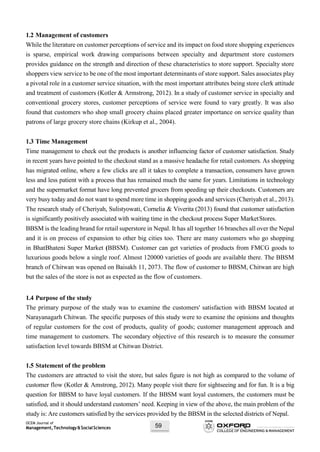
![OCEMJournalof
Management,Technology&SocialSciences60
2. Research Methods
The survey method was used to collect data for this study where 190 random customers of BBSW were
selected in different opening days and time. Thus collected primary data was tested for the reliability
using Cronbach’s Alpha, and various statistical tests were also applied. Chi-Square Test was computed
to find the differences of their preference between the male and female respondents. The Binary Logistic
Regression Analysis was used to find the association between the dependent variable (customer's
satisfaction) and independent variables (price of the product, employees' behaviour with customers,
discount rate, utilization of technology in buying and selling activities). The target population was
one thousand (n = 1000) customers and sample population was one hundred and ninety (n = 190). The
proportion of the sample population was [(n/Nx100)] 19 %. Two hundred and ten (n=210) respondents
were requested to fill the structured questionnaire, but only one hundred and ninety (n=190) respondents
filled the dispatched questionnaire. The response rate was [190/210x100] 90.47 %. Cronbach's Alpha
was computed for reliability of collected data of this study. The proportion of the male respondent
was [76/190x100] 39.12% (n =76) and the female respondent was [114/190x100] 60. 88% (n=114) had
participated in this study. After computing reliability test of the collected data, the data analysis was
carried out using different simple statistical tools (Cohen, Manion, Morrison, & Bell, 2011).
3. Results
Each survey instrument was examined by computing the factor analysis for the classification of variables
or detecting structure in relationship between variables. There were methods based on the assumption
that some variability in data was not explained by all the components. However, this study has limited
the discussion to use of factor analysis for the data reduction which has focused only on Principal
Component Model. The analysis has finalized the price of goods at BBSM, lower discount rate, discount
rate at BBSM, facilities and quality of products, facility of furniture and waiting room, better BBSM
employees behaviour, use of technology and clean environment, customer-centered services, varieties of
new goods and sound customer management, facilities and equipped technology, varieties of goods and
quality services and customer’s facilities and management (see in the Table 2). After computing, factors
loading of the survey instrument as the sub-scales of PCs (see in the Table 1). The analysis is based
on the empirical literature of customer relationship management (CRM) system for improved business
profitability, better customer-centered decision making, enhanced customer relations, and good quality
of services and product offerings. The underpinning of the customer-oriented managing concept is that
identification and satisfaction of customer needs lead to improved customer retention, which is based on
corporate profitability (Mithas, Krishnan & Fornell, 2005).
3.1 Factors loading of variables
The survey instrument has been divided in to four parts namely Group A, B, C and D. Each group has
questions measured in Likert scale. Factor Reduction Model was applied to find the close relationship
among variables within a group and to segregate variables in respective group of each survey group.
The groups are later given the name sub-scales. Following Table 1 shows variables of different groups
of questionnaires with their factors loading, these factors loading were used to group the variable in to
different subgroups.](https://image.slidesharecdn.com/finaljournal-201117003412/85/Dr-Basanta-Adhikari-60-320.jpg)



![OCEMJournalof
Management,Technology&SocialSciences64
Table 4. Summary of the significant predictors of the Wholesome Model of BLR (n = 190).
Independent variables B S. E. Wald df Sig.
Exp
(B)
95%C.IforExp(B)
Upper Lower
Use of technology and clean environment 0.134 0.19 0.497 1 0.481 1.143 1.657 0.788
Better Behaviour of BBSM employees 0.155 0.219 0.501 1 0.479 1.168 1.795 0.76
Customer Centered Service -0.096 0.18 0.286 1 0.593 0.908 1.293 0.638
Facilities and equipped store technology -0.329 0.18 3.336 1 0.068 0.72 1.024 0.506
Verities of products and quality service 0.193 0.215 0.804 1 0.37 1.213 1.849 0.795
Better customer management 0.438 0.171 6.552 1 0.01 1.549 2.166 1.108
Customers' facilities at BBSM -0.17 0.166 1.037 1 0.309 0.844 1.17 0.609
Constant -0.642 0.168 14.59 1 0.175
Before carrying out Binary Logistic Regression, some pre-required tests were conducted, the Omnibus
Tests [Chi-Square = 15.421, df = 7, p = .031] and associated P-value found less than 0.05, the present
model shows a decrease in deviance in prediction from the base model, showing that this model is better
fit compared to the base model. Hosmer and Lemeshow Test [5.641] shows that p = 0.687 > 0.05 is
insignificant which is good to support for the regression model fit. Again, the model summary table
shows the values of 2Log Likehood (213.274), Cox and Snell R2
and Nagelkerke R2
[8.30 % (Cox and
Snell) and 11.60 % (Nagelkerke)] variance of the model was explained by the independent variables.
Also the result shows that overall model gives 65.7 % percent correct prediction. The classification table
shows that the base model though, predicts correctly the number of satisfied customers but it does not
correctly predict the number of dissatisfied customers. Thus, it predicts satisfied customers with 90.2
percent accuracy and predicts 22.2 percent accuracy of dissatisfied customers at BBSM.
Results show that, out of 150 satisfied customers, this model predicts that 101 customers are satisfied
and 49 are dissatisfied. Again, out of 25 dissatisfied customers, this model predicts that 11 customers
are satisfied and 14 are dissatisfied (see in the Appendix 1). The results show that there is positively
statistically significant correlation between the better customer relationship management and customer
satisfaction at BBSM (p <0.05, B= .438). Again, when the independent variable the better customer
management increases one unit, customer satisfaction can be predicated to increase around 1.459 times
if other variables are controlled. This study has supported the findings of Mithas, Krishnan & Fornell
(2005). The study along with the current study summarized that the use of CRM applications is positively
associated with improved customer knowledge and improved customer satisfaction. This study also shows
that gains in customer knowledge are enhanced when firms share their customer-related information with
their supply chain partners.
But the results show that there is no significant relationship between customers centered service, facilities
and equipped technology used by BBSM, use of technology and maintain clean environment, varieties
of new and quality products and facilities and quality products of BBSM (p > 0.05). This study has
supported the empirical findings of Mithas, Krishnan & Fornell (2005) because both studies found that
customer relationship management was likely to have a positive effect on customer satisfaction, for
example, CRM applications enable firms to customize their offerings to each customer and also help
firms to gain customer knowledge which support firms improve their customer satisfaction infuture.](https://image.slidesharecdn.com/finaljournal-201117003412/85/Dr-Basanta-Adhikari-64-320.jpg)

![OCEMJournalof
Management,Technology&SocialSciences66
Customers' monthly income of BBSM customers
Above 30000
21000-30000
16000 - 20000
11000- 15000
5000 - 10000
Less than Rs 5000
0 20 40 60 80 100 120
Number of persons
Figure-3: Customers' monthly income
The results show that the highest number of BBSM customers' monthly income was ranked from NRS
21000 to NRS 30000. Again, the least percentage of BBSM customers' income level was more than NRS
30000 per month (see in the Chart 1).
4. Discussion and Conclusion
The primary objective of this study was to examine the customers' satisfaction at BBSM Bharatpur
Chitwan of Nepal. The quantitative approach was used as research methodology and the survey study was
used to as research method. The survey questionnaire was used to know the opinions and experiences of
the sampled customers on their satisfaction based on service quality, price level, employees’ service and
customer relationship management. The target population was one thousand and the sampled customers
were one hundred and ninety which is 19 % as the sampled population. The proportion of the male and
female population was [76/190*100] 39.12 % (n =76) and the female respondent was and [114/190*100]
60. 88 % respectively.
The total sample customers participated in this study was one hundred and ninety-one where the
response rate was 84.88%. The results show that there is positively statistically significant relationship
between use the better customer management and customer satisfaction at BBSM Bharatpur Chitwan
(p <0.05, B= 0.438). Again, when the independent the better customer management increases one unit,
customer satisfaction can be predicated to increase around 0.438 times if other variables are controlled.
The current study has supported the findings of ROH, AHN & HAN (2005). Both studies summarized
that the CRM system success model that consists of CRM initiatives: process fit, customer information
quality, and system support; intrinsic success: efficiency and customer satisfaction; and extrinsic
success: profitability. The results show that the main reason of choosing BBSM by the customer was
quality of products. The results further show that there is no significant relationship between customers
centered service, facilities and equipped technology used by BBSM, use of technology and maintain
clean environment, verities of new and quality products and facilities and quality products of BBSM (p >
0.05). The monthly incomes of the majority of customers was fallen on NRS 21000 to 30000. The results
Income(NRS)](https://image.slidesharecdn.com/finaljournal-201117003412/85/Dr-Basanta-Adhikari-66-320.jpg)

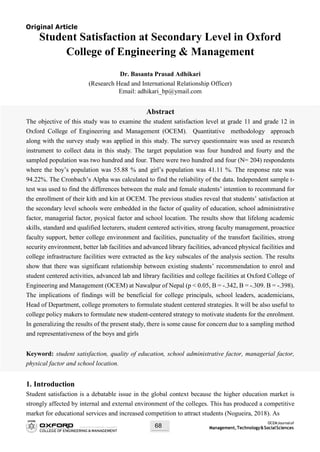
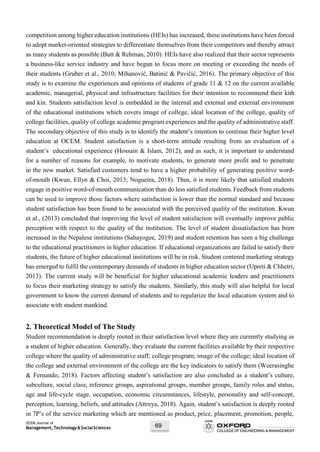
![OCEMJournalof
Management,Technology&SocialSciences70
s
n
f
o
l
l
i
Recommendation
of
Students’
Stafisfaction
f
process, physical evidence as mentioned by Gajic (2011). Here product means college program, price
means, fee of each course, placement means, internship and job guarantee, promotion means advertisement
of college, people means lecturers and administrative staff, process means different stages of program
completion and physical evidence means physical facilities of college (Prentice, Brady & McLaughlin,
2018). Again, improving the college program, reducing the tuition fee; improving the connection
with economic environment; the image of college; the academic staff; the management activities, and
improving the college facilities are key influencing factors of student’s satisfaction in higher educational
institutions (Hanssen & Solvoll, 2015).
Figure 1. Student Satisfaction Model for Higher Education in Nepal
3. Research Task and Problems
The quantitative research approach was applied in this study because this approach is useful to cover
larger sample population generates and statistically robust results that can be derived from quantitative
research are good for estimating the probability of success. The research method is the survey study and
the research instrument is the service questionnaire. The target population was four hundred and fifty
(n=440) where the sample population was two hundred and four (n=204) There were two hundred and
four (n= 204) respondents where the boy’s population was one hundred and fourteen (N=114) [55.88 %]
and girl’s population was ninety (n = 90) [41.11 % ].
The target population was four hundred and fifty (n = 440). The main research problem will examine the
student’s intention to recommend to recommend their kith and kin to enrol at higher secondary schools.
The first sub problem will examine the student’s experiences and opinions at grade 11 and 12 grade](https://image.slidesharecdn.com/finaljournal-201117003412/85/Dr-Basanta-Adhikari-70-320.jpg)
![OCEM Journal of
Management,Technology&SocialSciences 71
Quantitative
Approach
[The Survey
Research
Method]
Research
Instrument
[The Survey
Questionnaire]
Data Analysis
Method
[The
Descriptive
Stastistics]
Stastistical Tool
[Principal
Component
Analysis and
Chi-square]
Reliability
[Relibility Scale
Factor]
students on academic factor for their intention to recommend their friends/family members/relatives to
enrol at OCEM. The second sub problem will examine the student’s experiences and opinions of grade
11 and 12 grade students on managerial factors for their intention to recommend their kith and kin at
secondary level schools. The third sub problem will examine student’s experiences and opinions on
college’s physical factor for their intention to recommend their kith and kin to enrol at Secondary Level
Schools. The fourth sub problem will examine the experiences and opinions on college infrastructure
facilities for their recommendation to enrol their kith and kin to enrol at schools where they are currently
studying (Cohen, Manion & Morrison, 2011; Tucker, 2013. Saying so, the first main problem and its sub
problems have been presented as follows.
1. What are the key influencing factors affecting student’s intention to recommend their kith and kin to
of grade 11 and 12 in the college?
1.1. What is the impact of academic factor on student’s intention to recommend their friends/relatives/
family members to enrol at the college where they are currently studying?
1.2. What is the impact of managerial factor on student’s intention to recommend their friends/
relatives/family members to enrol at the college where they are currently studying?
1.3. What is the impact of physical factor on student’s intention to recommend their friends/relatives/
family members to enrol at the college where they are currently studying?
1.4. What is the impact of infrastructure factor on student’s intention to recommend their friends/
relatives/family members to enrol at the college where they are currently studying?
3. Methods
The survey research design was applied to collect data on student’s recommendation to their kith and kin
to enrol at the same college because this method is useful to cover a large sample population. The survey
research design which is used in this study has been presented below.
Source: Kothari, 2004
Figure 2 Research design of quantitative method](https://image.slidesharecdn.com/finaljournal-201117003412/85/Dr-Basanta-Adhikari-71-320.jpg)



![OCEM Journal of
Management,Technology&SocialSciences 75
than the disagreed to natural to recommend their kith and kin to enrol at OCEM. The results show that
the mean score of the male student of the subscale strong faculty management (M = 2.10, SD = .80) do
not statistically significantly differ [t (202) = .893, p = 0.373 from that of the female students on the same
variable (M = 2.01, SD = .60). Similarly, the mean score of the male students of the subscale standard
lecturers (M = 2.29, SD = 0.85) did not differ statistically significantly [t (202) = 1.419, p = 0.157 from
that of the female students on the same variable (M = 2.13 SD = 0.67). But, the mean score for the male
students on the subscale student cantered activities (M = 2.36, SD = 0.87) is statistically significantly
higher [t (200.80) = 2.605, p = .012] from that of the female student on the same variable (M = 2.06, SD
= 0.71, Cohen’s d = 0.37) signifying that boys had have more intended to recommend their kith and kin to
enrol at OCEM than girls. The results further show that the mean score for the male students (n=116) on
the subscale lifelong academic skills (M = 2.33, SD = 0.60) is statistically significantly higher [t (194.45)
= 2.505, p = .013] than that of the female students (n=88) on the same variable (M = 2.12, SD = 0.56,
Cohen’s d 0.36) signifying that male students had have high intention to recommend their kith and kin
for the enrolment at OCEM than the female students. Moreover, the mean score of the male students of
the subscale better lab and library facilities (M = 2.33, SD = .82) do not statistically significantly lower
[t (202) = 1.068, p = 0.287 than that of the female students on the same variable (M = 2.21, SD = .84).
Again, the mean score of the male students of the subscale better college environment and facilities (M
= 2.43, SD = .74) is statistically significantly higher [t (199.72) = 2.102, p = 0.03] from that of the female
students on the same variable (M = 2.23, SD = .62), signifying that boys were more intended to recommend
their kith and kin for the enrolment where they are currently studying. Additionally, the mean score of the
male students of the subscale college physical facilities (M = 2.52, SD = .93) do not statistically significantly
differ [t (202) = 1.405, p = 0.162] than that of the female students on the same variable (M = 2.34, SD =
.85). Again, the mean score for the male students on the subscale proactive faculty support (M = 2.60, SD
= 1.05) did not differ statistically significantly [t (202) = 1.245, p = .214] from that of the female student on
the same variable (M = 2.42, SD = 1.01). Again, the mean score of the male students of the subscale better
transportation system (M = 2.81, SD = 1.03) do not statistically significantly differ [t (202) = .885, p = 0.377
from that of the female students on the same variable (M = 2.69, SD = .95). Again, the mean score for the
male students on the subscale college infrastructure facilities (M = 2.91, SD = .80) did not differ statistically
significantly [t (202) = -.906, p = 0.656] than that of the female student on the same variable (M = 2.92, SD
= .89). Finally, the mean score for the male students on the subscale strong security environment (M = 2.86,
SD = 1.14) did not differ statistically significantly [t (202) = -.954, p = .341] from that of the female student
on the same variable (M = 3.02, SD =1.18).
5.1ResultsofChi-SquareTestbetweenthelocationoftheexistingstudentsandtheirrecommendation
to enrol at OCEM.
The results of crosstabulation of different locations of existing students and the students’ intention of
recommendation to their kith and kin to enrol at OCEM shows that out of 204 sample students, 50
students from campus periphery, 42 students from Eastern Chitwan, 9 students from Western Chitwan
and 29 from other location were found positive to recommend their kith and kin. But out of 204 students,
22 students from campus periphery, 22 from Eastern Chitwan, and 15 from Western Chitwan and 14](https://image.slidesharecdn.com/finaljournal-201117003412/85/Dr-Basanta-Adhikari-75-320.jpg)
![OCEMJournalof
Management,Technology&SocialSciences76
from other location showed their intention not to recommend their kith and kin to enrol at OCEM. This
shows that there is association between different locations of existing students and students’ intention for
recommendation for the enrolment at OCEM.
Table 3. Chi-Square table of location of existing students at OCEM
and their recommendation preference (N=204).
The Table 3 provides that the value of Chi-Square is 10.273a
and associated significance value is
0.036<0.05. Therefore, the hull hypothesis is rejected, and signifying that there is association between the
location of existing students and students’ intention to recommend their friends/relatives/family members
to study at OCEM.
5.2 Logistic regression Wholesome Model of the significant indicators
Three independent variables were found significance from the whole independent variables of this
study. All three significant indicators of student’s intention to recommend their friends/family members/
relatives for the enrolment in the same college where they are currently enrolled students were entered
into the Binary Regression Model. Only two indicators were found significant for the student’s intention
to recommend for the enrolment at OCEM. The equation of independent and dependent variable under
the Binary Logistic Regression Model is embedded in logit(P) = b0+b1x1+b2x2+………..bnxn where p
is used to represent the odds ratio and the formula of odds ratio[ odds = p/1-p i.e. numerators p denotes
probability of presence and denominator p is equal to probability of absence(Cohen et al,. 2007).
Table 2. Binary Logistic Regression Wholesome Model of the impact of different factors on the
intention of student’s recommendation for the enrolment at their own college (N = 204).
Independent variables B S. E Wald df Sig.
Exp
(B)
95% C.I forExp (B)
Upper Lower
Strict student centred activities -.342 .158 4.676 1 .032 .710 .521 .968
Better ab and library facilities .309 .168 3.389 1 .066 1.362 .980 1.891
Weakcollegeinfrastructurefacilities -.398 .157 6.934 1 .011 .672 .494 1.891
Constants -.640 .156 16.913 1 .000 .527
The Omnibus Tests [Chi-Square = 16.712, df = 3, p =.110 and associated significance level is greater than
0.05, the present model shows a decrease in deviance from the base model because Chi-Square is positive,
showing this model is better fit compared the base model. The model summary table shows the values
of -2 Log Likehood (243.483), Cox and Snell R2
and Nagelkerke R2
[8 % (Cox and Snell) and 11% %
(Nagelkerke)] variance of the model was explained by the independent variables. Hosmer and Lemeshow
Test shows that p = 0.110 > 0.05 is insignificant which is good to support for the regression model fit. The
Chi-Square Tests
Values df Asymptotic Significance (2-sided)
Pearson Chi-Square 8.957
4 0.036
Likelihood Ratio 8.574 4 0.037
Linear-by-Linear Association 1.538 1 .215
N of Valid Cases 204](https://image.slidesharecdn.com/finaljournal-201117003412/85/Dr-Basanta-Adhikari-76-320.jpg)



![OCEMJournalof
Management,Technology&SocialSciences80
Vogt, W. (2011). SAGE quantitative research methods. Los Angeles [Calif.]: SAGE.
Weerasinghe, I. and Fernando, R. (2018). Critical factors affecting students’ satisfaction with higher
education in Sri Lanka. Quality Assurance in Education, 26(1), 115-130.
Yusoff,M.,McLeay,F.andWoodruffe-Burton,H.(2015).Dimensionsdrivingbusinessstudentsatisfaction
in higher education. Quality Assurance in Education, 23(1), 86-104.
APPENDIX 1
Observed
Predicted QN17
Percentage
Correct
Intention to
recommend
Does not intend to
recommend
QN17
Intention to recommend 168 36 91.5
Does not intend to recommend 0 11 35.2
Overall Percentage 71.5](https://image.slidesharecdn.com/finaljournal-201117003412/85/Dr-Basanta-Adhikari-80-320.jpg)
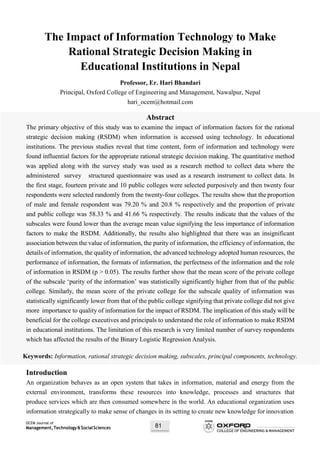







![OCEM Journal of
Management,Technology&SocialSciences 89
in predetermined sequence) is crucial for RSDM, Presentation of the information (narrative, numeric,
graphic, sound, animated form etc.) is crucial for RSDM and media of the information (in the form of
printed paper documents, video display and other media) is crucial for RSDM. Similarly, the mean value
of the perfectness of the information is lower than the formats of information signifying that respondents
perceived their opinions between the strongly disagree and disagree with the statements of comparable of
the information is crucial for RSDM, unambiguous of the information is crucial for RSDM and clarity of
the information is crucial for RSDM. Finally, the mean value of the advanced technology adapted human
resource is also lower than the average value signifying that respondents showed their disagreement
with the statements of skill of human resource is crucial for RSDM., use of the technology is crucial for
rational strategic decision making RSDM, capacity of the technology is crucial for RSDM, knowledge
about technology is crucial for RSDM and the latest version of the technology is crucial for RSDM. But
the mean value of the performance of the technology is higher than the advanced technology adapted
HR and lower than the average mean value signifying that respondents showed their disagreement with
the statements of speed of the technology is crucial for RSDM, durability of the technology is crucial for
RSDM and availability of the technology is crucial for RSDM.
4.1.3 Results of the independent sample t-Test
Two basic experimental designs were employed to examine differences in two groups (Private College
& pubic college).
H0: There is no significant difference in average percentage of impact of information to make RSDM in
educational institutions.
H1
: There is significant difference in average percentage of impact of information to make RSDM in
educational institutions.
The results show that the mean score for the private college (n = 14) on the first subscale value of
information (M = 1.46, SD = 0 .67) did not differ statistically significantly [t (22) = 1.331, p = 0.197] from
that of public college (n = 10) for the same variable (M =1.48, SD = 0.29), hence the null hypothesis is
accepted. Similarly, the mean score of the private college of the second subscale purity of the information
(M = 1.43, SD = 0.53) is statistically significantly higher [t (11.11) = -.2.472, p = 0.01] than that of the
public college (M = 2.27, SD = 0.93), hence H1
is rejected. Again, the mean score of third subscale
for the private college on efficiency of the information (M = 1.63, SD = 0.48) was not statistically
significantly different [t (22) = -1.081, p = 0.291] from that of the public college (M = 1.83, SD = 0.35).
Similarly, Again, the mean score of the fourth subscale details of information for the private college on
the fourth subscale details of the information and growth (M = 1.53, SD = 0.71) did not differ statistically
significantly [t (22) = 1.405, p = 0.174] from that of public college for the same variable (M =1.20, SD
= .258). Similarly, the mean score of the private college of the fifth subscale quality of information (M
= 2.00, SD = 1.01) was statistically significantly lower [t (119.70) = -3.673 p = 0.001] than that of the
public college (M =3.70, SD = 1.18) signifying that private college does not give importance to quality
of information for the RSDM than the public college. The results show that the mean score for the private
college on the sixth subscale formats of information (M = 2.25, SD = 1.13) did not differ statistically
significantly [t (22) = .901, p = 0.377] from that of public college for the same variable (M =1.85, SD](https://image.slidesharecdn.com/finaljournal-201117003412/85/Dr-Basanta-Adhikari-89-320.jpg)
![OCEMJournalof
Management,Technology&SocialSciences90
= 0.241), hence the null hypothesis is accepted. Similarly, the mean score for the private college on the
seventh subscale perfectness of information (M = 1.59, SD = .681) did not differ statistically significantly
[t (22) = .123, p = 0.903] from that of public college for the same variable (M =1.56, SD = 0.316), hence
the null hypothesis is accepted. Additionally, the results show that the mean score for the private college
on the eighth subscale advanced technology adapted human resource (M = 1.81, SD = .778) did not
differ statistically significantly differ [t (22) = 0.390, p = 0.700] from that of public college for the same
variable (M =1.85, SD = 0.241), hence the null hypothesis is accepted. Similarly, the mean score for the
private college on the ninth subscale performance of information (M = 2.16, SD = .448) did not differ
statistically significantly [t (22) = .915, p = 0.370] from that of public college for the same variable (M
=1.93, SD = 0.798).
4.1.4. Results of Logistic Regression Model
Binary Logistic Regression Model (BLRM) was used to find the effects of the independent variable (the
value of information, the purity of information, the efficiency of information, the details of information,
the quality of information, the advanced technology adapted human resource) on the dependent variables
(the rational strategic decision making).
Table 3. Summary of the independent’s predictors of the Wholesome
Model of Quantitative findings (n = 24).
There were nine basic measurement scales in quantitative result section, but all nine indicators were found
insignificant for the rational strategic decision making (see in the table 3). With the Omnibus Tests [Chi-
Square = 18.08, df = 9, p =.034 and associated significance level less than 0.05, the present model shows
a decrease in deviance from the base model because Chi-Square is positive, showing this model is better
fit compared to the base model. The model summary shows the values of -2Log Likelihood (0.000a
), Cox
and Snell R2
and Nagelkerke R2
[52.90 % % (Cox and Snell) and 100 % (Nagelkerke)] variance of the
model was explained by the independent variables. Hosmer and Lemeshow Test shows that p = 1.00 >
0.05 is insignificant which is good to support for the regression model fit. The classification table shows
that out of 24 school leaders 21 showed their opinion on the role of information is important to make
rational strategic decision making in educational institutions, this model predicts 3 school leaders showed
Independent variables B S. E. Wald df Sig. Exp (B)
The value of information 5.194 3.27 2.510 1 .113 180.142
The purity of information 2.334 1.672 1.949 1 .163 10.318
The efficiency of information 5.330 2.907 3.363 1 .067 206.435
The details of information 6.535 5.014 1.699 1 .192 689.025
The quality of information 1.855 1.701 1.190 1 .275 6.394
The advanced technology adapted HR -12.619 7.593 2.762 1 .097 .000
The performance of technology -3.457 1.927 3.218 1 .073 .032
The format of information 3.251 2.412 1.817 1 .178 25.820
The perfectness of information -1.369 1.071 1.634 1 .201 .254
Constant -6.575 3.473 3.584 1 .058 .001](https://image.slidesharecdn.com/finaljournal-201117003412/85/Dr-Basanta-Adhikari-90-320.jpg)



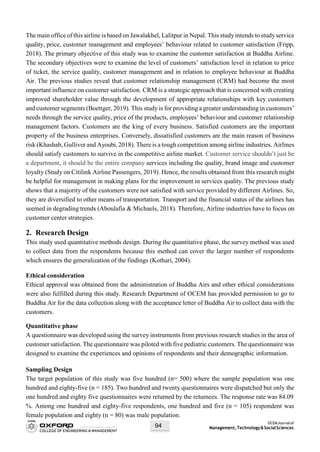
![OCEM Journal of
Management,Technology&SocialSciences 95
Method of Data Collection
The questionnaire was circulated to all 185 customers registered with the Buddha Air, Bharatpur Chitwan.
The customers were all registered in Buddha Air’s Webpage before two years ago. A link to the web-
based questionnaire was sent via email to all paediatric customers in Buddha Air. A reminder email was
circulated 2 weeks later. The responses were anonymous and could not be linked to the email address.
Processing and Analyzing of Data
The survey data were analysed using simple descriptive statistics and correlations. Principal compnent
analysis via Factor Reduction Model was applied to find the new principal components (PCs). Again,
Linear Regression Model was used to find the correlation between the selction of Buddha Air and gender
of the population.
3. Results
The data analysis was based on descriptive statistics analysis. The analysis is embedded in the subscales,
Chi-square test, categorical variables of the Linear Regression Model and the principal components.
3.1 Data Analysis
Factor analysis was used to reduce the large number of variables to a small number of components. The
demand for the air services has increased manifold in the past some years. Buddha Air as an air service
providerwas examinedforfactorsinfluencingcustomersatisfactionagainstitscurrentticketprices,service
quality, employees’ behaviour and customer management. This study undertakes a survey of 185 service
users of Buddha Air who fly from Bharatpur to Kathmandu and vice versa. Respondents were contacted
via telephone and were asked to rate forty-eight statements on their perceptions and experiences about
the Airline’s service quality, employee’s behaviour, customer management strategy and ticket’s prices on
a 5-point Likert scale [Completely dissatisfied =1, Dissatisfied =2, I do not know =3, Satisfied =4 and
completely satisfied =5]. The concept of data reduction is based on the fact that few components explain
most of the variance in dependent variable (Factors influencing customer’s satisfaction) (Pandya et al.,
2018). KMO and Bartlett’s Test was used to ensure the sample sufficiency for the further analysis of the
PCs where the minimum value of KMO was fixed < 0.60. Previous study had sometimes relied heavily
on a single-item indicator of customer’s’ satisfaction and preference which maximizes the possibility of
measurement error (e.g. Watt &Richardson, 2007). To construct this requirement, this study has chosen
to work with more encompassing constructs, measured by multiple items. To identify these underlying
themes inthequestionnaire, aPrincipal Component Analysis (PCA)was run. Subsequently,an Exploratory
Factor Analysis (EFA) with Varimax rotation was carried out to refine and interpret these components.
The reliability of the data was checked by computing scale analysis where the minimum value of the
Cronbach’s Alpha was considered over 0.60 (Cohen et al. 2011).
Eigenvalues, the screen plot and theoretical interpretability were also used to make a decision on the
number of factors. A factor loading of at least [0.40] was taken as cut-off point to incorporate a specific
item as an indicator for an understanding motive. To explore the relation between customers’ satisfaction
and personal variables, descriptive statistics and cross tabulations were computed (Pandya, Bulsari &
Sinha, 2018). Descriptive statistics was further employed to analyze customers’ ‘ motives (satisfaction) for
current service facilities, prices of the tickets, customer management strategy and employee’s behaviour](https://image.slidesharecdn.com/finaljournal-201117003412/85/Dr-Basanta-Adhikari-95-320.jpg)
![OCEMJournalof
Management,Technology&SocialSciences96
towards customer’s satisfaction at Buddha Air. Again, the Chi-square Test was computed to examine the
association between customer satisfaction and categorical variables (gender, average family income level,
profession of the customers, main reasons of choosing Buddha Air, different religions of the customers).
A stepwise strategy was followed (Easterby-Smith, Thorpe & Jackson, 2012). Secondly, a Binary Logistic
Regression Model was used to assess the impact of the predictor and control variables on all motives of
customer’s satisfaction. Both significant levels and effective sizes were considered using Cohen’s d cut-off
points (Cohen, Manion, & Morrison, 2011). Finally, the Wholesome Binary Logistic Regression Model
was applied to find the association between all the significant indicators and customer satisfaction.
3.2. Quality Factor
The first research instrument was examined by the first survey instrument where respondents were
asked to share their experiences and perceptions on environmental cleanness, noise pollution, customers
waiting place, easy and comfortable seats, quality of drinking water, facility of using Visa/Master/Debit/
Credit Card to purchase tickets, feeling of customers’ facilities, money exchange facility, punctuality of
flights, adequate overhead facilities and safety of airline flights.
Table1. Varimax rotated principal components matrix on the quality of services for the customers
satisfaction before and after service of Buddha Airs (N = 185).
The Principal Component Model extracted three PCs where the first PC has five variables, the second
PC has three variables and the third PC has four variables. The variances of the first, second, and third
account were 26.05 %, 13.43 %, and 10.80 % respectively [KMO = 0.0678]. The first, second, and third
PCs were named as the proper shopping environment, quality of services and strict flight schedule and
security respectively in Buddha Air.
Variables
Loadings
1 2 3
PROPER SHOPPING ENVIRONMENTAND CUSTOMER MANAGEMENT
There is no sound pollution in the location of Buddha Airs. .700
The seats are comfortable and easy. .689
The is sufficient waiting place for customers in Buddha Air’s Office .655
The environment is neat and clean in Buddha Airs. .614
There is no sound pollution while taking off Buddha Air. .424
QUALITY SERVICES
Buddha Air Service accepts Visa and other online payment cards. .807
The food and beverage are quality and satisfactory. .748
I feel comfortable service of Buddha Airs. .645
STRICT FLIGHT SCHEDULE AND SECURITY
Buddha Air is punctual in its schedule. .826
The Airlines is safety than other Airlines. .762
The is the facility of money exchange around the counter. .623
The Airlines has overhead luggage facility. .591](https://image.slidesharecdn.com/finaljournal-201117003412/85/Dr-Basanta-Adhikari-96-320.jpg)
![OCEM Journal of
Management,Technology&SocialSciences 97
Table2.Mean, standard deviation and Cronbach’sAlpha forthescalesforquality of
services of Buddha Airs for customers’ satisfaction (N=185).
The mean values of three subscales were 3.41, 3.16, and 3.37 respectively. The overall mean values of the
first, second and third subscales had been seen more than the average value signifying that customers were
approximately agreed with the statements that proper shopping environment and customer management,
service qualityand strict flightscheduleandsecurityweresatisfactoryin BuddhaAir(seein detailin Table2).
Table3. Binary logistic regression model of the quality of services for customers’
satisfaction (N = 185).
With the Omnibus Tests [Chi-Square = 36.273, df = 3, p = .001] and associated significance level less
than 0.05, the present model shows a decrease in deviance in prediction from the base model because
the value of Chi-Square is positive. So that this model is better fit compared the base model. The model
summary table shows the values of -2Log Likehood, Cox and Snell R2
and Nagelkerke R2
[17.80 % (Cox
and Snell) and 38.80 % (Nagelkerke)] variance of the model was explained by the independent variables.
Hosmer and Lemeshow Test shows that p = 0.129 > 0.05 is insignificant which is good to support for
the regression model fit. Out of 176 customers who chose the first option [satisfied with the service of
Buddha Air], this model predicts 163 customers showed their satisfaction for Buddha Air services and
13 customers showed their dissatisfaction for the Airline services. Again, out of 9 customers who showed
their dissatisfaction for Buddha Air services, the results show that 5 customers were found dissatisfied
and 4 customers were found satisfied for the services of Buddha Airs. Thus, it predicts that customers
who showed their satisfaction for the services with 97.00 percent accuracy and the customers who
showed their dissatisfaction for the airline services was 23.5 percentage accuracy. The classification table
shows that the overall percentage of correct prediction was 90.3 percent. The results show that there was
significant association between strict flight schedule and security in and customers’ satisfaction (p < 0.05
with odds ratio = .198 < 1, B = -1.621 <0) indicating a negative impact on customers’ satisfaction. When
the independent variable high-level facilities and security increases one unit, customer satisfaction can
be predicated to decrease around 0.198 times if other variables are controlled. This study has supported
the previous findings of de Lange, Samoilovich & van der Rhee (2013) because both the current and the
previous studies de Lange et al (2013) have found that airlines’ customers were dissatisfied with strict
flight schedule and lengthy securityprocesses.
Subscales Mean SD Cronbach’s Alpha
Proper shopping environment and customer management 3.41 0.69 0.65
Quality of services 3.16 0.81 0.70
High level facilities and security 3.37 0.72 0,60
Independent Variables B S. E. Wald df Sig.
Exp
(B)
95% C.I for
Exp (B)
Upper Lower
Proper shopping Env. and customer
management
-.457 .242 3.565 1 0.059 .633 1.018 .394
Quality of services -.391 .323 1.459 1 0.227 .677 1.275 .359
Strict flight schedule and security -1.621 .346 21.833 1 .000 .198 .390 .100
Constant -3.384 .491 47.424 1 .000 .034](https://image.slidesharecdn.com/finaljournal-201117003412/85/Dr-Basanta-Adhikari-97-320.jpg)
![OCEMJournalof
Management,Technology&SocialSciences98
4.2. Price factor
The second research instrument intends to examine the perceptions and experiences of customers on the
price level of Buddha Air’s ticket and their satisfaction level. The survey instrument was embedded in the
price fluctuation, the comparison of ticket’s price, facility and discount issues of online ticket buying and
selling, and reasonable price of air tickets (Chow, 2014).
Table4. Varimax rotated principal components matrix on the price of Buddha Air
ticket for the customers satisfaction (N = 185).
The Principal Component Model extracted two PCs where the first PC has three variables, and the second
PC has four variables. The variances of the first and second, Principal Components account for 30.37%
and 14.85% respectively [KMO = 0.0658]. The first and second PCs were named as the price of ticket and
nature of ticket pricerespectively.
Table5. Mean, standard deviation and Cronbach’sAlpha forthe scales forthe price of
Buddha Air ticket for the customers satisfaction (N=185).
The mean values of two subscales were 2.49 and 2.93 respectively. The overall mean values of the first and
second subscales had been lower than the average value signifying that customers were not satisfied with
the statements that the price of the ticket in Buddha Air was cheaper and the fluctuations in ticket price
occur time and again (see in detail in Table 5).
Table6. Binary logistic regression model of the price of Buddha Air ticket
for the customers’ satisfaction (N = 185).
The Omnibus Tests [Chi-Square = 9.295, df = 2, p = .010] and associated significance level less than 0.05,
Variables
Loadings
1 2
Price of Tickets
Online ticket purchase price of Buddha Air is similar with other airlines. .859
The cost price of ticket in Buddha Air is equal to other Air lines. .803
The price of the ticket in earlier booking is cheaper in Buddha Airs. .487
Fluaction in Ticket Price
There is price fluctuation in Buddha Airs. .865
The ticket price is consistence in Buddha Airs. .682
The ticket price of the Buddha Air is cheaper. .525
The ticket price in Buddha Air is constant. .520
Subscales Mean SD Cronbach’s Alpha
Price of tickets 2.49 .086 0.65
Fluctuation in ticket price 2.93 0.60 0.60
Independent variables B S. E. Wald df Sig. Exp (B)
95% C.I for Exp (B)
Upper Lower
Prices of tickets -.154 .259 .355 1 .552 .857 1.423 .517
Fluctuation in ticket price -.747 .252 8.776 1 .003 .474 .777 .289
Constant .304 -2.526 68.880 1 .000 .080](https://image.slidesharecdn.com/finaljournal-201117003412/85/Dr-Basanta-Adhikari-98-320.jpg)
![OCEM Journal of
Management,Technology&SocialSciences 99
the present model shows a decrease in deviance in prediction from the base model because the value of
Chi-Square is positive. So this model is better fit compared to the base model. The model summary table
shows the values of -2Log Likehood, Cox and Snell R2
and Nagelkerke R2
[4.90 % (Cox and Snell) and
10.70 % (Nagelkerke)] variance of the model was explained by the independent variables. Hosmer and
Lemeshow Test shows that p = 0.268 > 0.05 is insignificant which is good to support for the regression
model fit. Out of 185 customers who chose the first option [satisfied with the price of Buddha Air],
this model predicts 168 customers showed their satisfaction for the ticket price of Buddha Airs and 17
customers showed their dissatisfaction for the price of Airline services. Thus, it predicts that customers
who showed their satisfaction for the price of tickets with 100.00 percent accuracy. The results show that
the overall percentage of correct prediction is 90.8 percent. The results show that there was significant
association between fluctuations in tickets’ price and customers’ satisfaction (p < 0.05 with odds ratio =
.474 <1, B = -747 < 0) indicating a negative impact of ticket price on customers’ satisfaction in Buddha
Air Service. When the independent variable fluctuation in tickets’ price increases one unit, customer
satisfaction can be predicated to decrease around 0.474 times if other variables are controlled. This study
has supported the previous study of Aligholi (2014) because this study has also highlighted that fluctuation
in tickets’ price made customers dissatisfied which is also highlighted by this study.
3.3. Service quality of the employees of Buddha Airs
The third research instrument intended to examine the association between employees behaviour and
customers satisfaction in Buddha Air. The third survey instrument was embedded in the polite behaviour
ofAirhostess,employees’politenesstocustomers,motivationofemployeestodeliverservicetocustomers,
servicesforentertainment,useofnewtechnologicaltools,cooperativebehaviourofemployees,satisfaction
of the services delivered by Buddha Airs, realization of mistakes by employees, service of ATM around
Airline counters, fulfillment of employees’ responsibilities on time, customer centered employees and
polite behaviour of pilots.
Table7.Varimaxrotated principal components matrix on the employees’
behaviour on the customers satisfaction (N = 185).
Variables
Loadings
1 2 3 4
SERVICE QUALITY AND EMPLOYEE’S BEHAVIOUR
Employees are polite in the area of Buddha Air’ counter .841
Employees are highly interested to provide services to customers. .667
The service quality of Buddha Airs is satisfactory. .620
EMPLOYEE MISTAKES AND ENTERTAINMENT
There are entertainment services in Buddha Airs. .721
Employees of Buddha Airs realize their mistakes while dealing. .630
Employees are customer centred in Buddha Airs. .594
PILOT BEHAVIOUR AND EMPLOYEE COOPERATION
Buddha Air has used new technological tools in its services. .831
The employees of Buddha Airs are cooperative and helpful. .603
The pilots are polite while dealing with customers. .501](https://image.slidesharecdn.com/finaljournal-201117003412/85/Dr-Basanta-Adhikari-99-320.jpg)
![OCEMJournalof
Management,Technology&SocialSciences100
COMPETENT EMPLOYEES AND ATM SERVICE FACILITY
18.9. There is ATM service around the ticket counter. .851
18.10. The employees fulfil their assigned duties on time. .739
18.1. The behaviour of Air Hostess is polite and helpful .523
The Principal Component Model extracted four PCs where the first, second, third and the fourth PC have
three variables each. The variances of the first, second, third and the fourth Principal Components account
for 34.88 %, 12.85 %, 10 % and 9 % respectively [KMO = 0.721]. The first and second, third and the fourth
PCs were named as employee motivation and politeness, customer centered strategy and positive attitude
of employees, pilot behaviour and employees’ cooperation and competent employees and service facilities
respectively.
Table8.Mean, standarddeviationand Cronbach’sAlphaforthescalesforemployees’
behaviour for the customers satisfaction(N=185).
The mean values of four subscales were 2.41, 2.74, 2.66 and 2.55 respectively. The overall mean values
of the first, second, third and fourth subscales had been seen lower than the average value signifying
that customers were approximately dissatisfied with the statements that service quality and employees’
behaviour, employee mistakes and entertainment facilities, pilot behaviour and employees’ cooperation
and competent employees and service facilities from Buddha Air Service (see in details in table 8).
Table9. Binary logistic regression model of employees’ behaviour
for customers’ satisfaction (N =185).
The Omnibus Tests [Chi-Square = 14.844, df = 4, p = .005] and associated significance level less than 0.05,
the present model shows a decrease in deviance in prediction from the base model because the value of Chi-
Square is positive. So that this model is better fit compared the base model. The model summarytable shows
the values of -2Log Likehood, Cox and Snell R2
and Nagelkerke R2
[7.700 % (Cox and Snell) and 16.80 %
(Nagelkerke)] variance of the model was explained by the independent variables. Hosmer and Lemeshow
Test shows that p = 0.119 > 0.05 is insignificant which is good to support for the regression model fit. Out
of 181 customers who chose the first option [satisfied with the employee behaviour of Buddha Airs], this
Subscales Mean SD Cronbach’s Alpha
Service quality and employee's behaviour 2.41 0.78 0.67
Employee mistakes and entertainment facilities 2.74 .080 0.60
Pilot behaviour and employees' cooperation 2.66 0.91 0.65
Competent employees and service facilities 2.55 0.86 0.63
Independent variables B S. E. Wald df Sig.
Exp
(B)
95 % C.I for
Exp (B)
Upper Lower
Service quality and employee’s behaviour -.566 .244 5.396 1 .020 .568 .915 .362
Employee mistakes and entertainment facilities -.649 .302 4.627 1 .031 .523 .944 .289
Pilot behaviour and employees’ cooperation -.307 .267 1.318 1 .251 .736 .1.242 .436
Competent employees and service facilities .041 .252 0.26 1 .872 1.042 1.708 .635
Constant -2.631 .323 66.303 1 .000 .072](https://image.slidesharecdn.com/finaljournal-201117003412/85/Dr-Basanta-Adhikari-100-320.jpg)
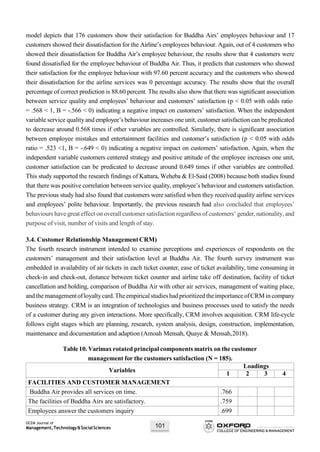
![OCEMJournalof
Management,Technology&SocialSciences102
There is proper waiting room management for customers in Buddha. .490
FACILITIES TO BUY TICKETS
The ticket is easily available to customers. .840
Tickets are available in each service counter. .819
FACILITIES OF TICKET POSTPONE AND CANCELLATION
There is the facility of ticket postpone. .831
There is ticket cancellation facility. .769
Ticket counter is close to plane take off area. .523
USE OF ADVANCED TECHNOLOGY FOR CUSTOMER MANAGEMENT
Less time is consumed in check-in and check-out. .646
Buddha Air is better than other airlines. .645
There is the facility of Loyalty card in Buddha Air Service. .500
The Principal Component Model extracted four PCs where the first PC has four variables, the second PC
has two variables, the third PC has three variables and the fourth PC has three variables respectively. The
variances of the first, second, third and fourth Principal Components account for 40.45%, 20.37%, 15.35%
and 14.85% respectively [KMO = 0.0628]. The first, second, third and the fourth PCs were named as ‘facility
and customer management facilities to buy tickets, facilities to postpone & cancel tickets and use of advanced
technology’ for customersatisfaction.
Table11.Mean, standard deviation and Cronbach’sAlphaforthescalesfor
employees’ behaviour for the customers satisfaction (n=185).
The mean values of four subscales were 2.49, 2.85, 2.59 and 3.27 respectively. The overall mean values
of the first, second, and third subscales had been seen a bit lower than the average value signifying that
customerswereapproximatelydissatisfied with the statements thatthefacilities tobuytickets, and facilities
of ticket postpone and cancellation in Buddha Air. But the mean value of the fourth subscales had seemed
higher than the average value signifying that customer were approximately satisfied with the technology
used to manage customers in Buddha Air (see in detail in table 8).
Table 12. Binary Logistic Regression Model on Customer Satisfaction at Buddha Air (N = 185).
Independent variables B S. E. Wald df Sig.
Exp
(B)
95%C.IforExp(B)
Upper Lower
Facilities and customer management .700 .347 4.082 1 .043 2.014 3.973 1.021
Facilities to buy tickets .006 .256 0.001 1 .980 1.006 1.661 .610
Facilities of ticket postpone and cancellation .682 .371 3.381 1 .066 1.978 4.092 .956
Use of advanced technology for customer management -.427 .402 1.125 1 .289 .653 1.436 .297
Constant 4.728 1.742 7.369 1 .007 .009
Subscales Mean SD Cronbach’s Alpha
Facilities and customer management 2.49 0.73 0.66
Facilities to buy tickets 2.85 1.14 0.76
Facilities of ticket postpone and cancellation 2.59 0.70 0.61
Use of advanced technology for customer management 3.27 0.71 0.60](https://image.slidesharecdn.com/finaljournal-201117003412/85/Dr-Basanta-Adhikari-102-320.jpg)
![OCEM Journal of
Management,Technology&SocialSciences 103
The Omnibus Tests [Chi-Square = 10.602, df = 4, p = .031] and associated significance level less than
0.05, the present model shows a decrease in deviance in prediction from the base model because the
value of Chi-Square is positive. So that this model is better fit compared with the base model. The result
of model summary show the values of -2Log Likehood, Cox and Snell R2
and Nagelkerke R2
[5.60 % (Cox
and Snell) and 12.10 % (Nagelkerke)] variance of the model was explained by the independent variables.
Hosmer and Lemeshow Test shows that p = 0.087 > 0.05 was insignificant which is good to support
for the regression model fit. Out of 185 customers who chose the first option [satisfied with the customer
management at Buddha Air], this model depicts that 168 customers showed their satisfaction for customer
management at Buddha Airs and 17 customers showed their dissatisfaction for the customer management at
Buddha Airline. Thus, it shows that customers who showed their satisfaction for the customer management
at Buddha Air with 100.00 percent accuracy. The results show that the overall percentageof correct prediction
is 90.80 percent. The results also show that there is significant association between facilities and customer
management and customers’ satisfaction (p < 0.05 with odds ratio = B = .700 > 0) indicatinga positive impact
on customers’ satisfaction. When the independent variable facilities and customer management increases
one unit, customer satisfaction can be predicated to increase around 2.014 times if other variables are
controlled. This study has supported the study of Hui, Zhang & Zheng (2013) because Hui et al. (2013) had
also found that facilities and customer management of communal facilities was the most crucial dimension
with regard to the overall customer satisfaction and communication efficiency and efficacious promotion
events are alsoimportant for maintaining customer satisfaction.
Binary Logistic Wholesome Model on Customer Satisfaction at Buddha Air
All the significant indicators selecting from each Binary Logistic Regression Tables (see in the table 3, 6,
9.12) were entered the Binary Logistic Regression Model. The main purpose of this analysis was to find
the Wholesome Model on customer satisfaction at BuddhaAir.
Table 13. Binary Logistic Wholesome Model on Customer Satisfaction at Buddha Air (N = 185).
Independent variables B S. E. Wald df Sig.
Exp
(B)
95 % C.I for Exp (B)
Upper Lower
Fluctuation in ticket price -.582 .289 4.046 1 .044 .599 .985 .317
Employee motivation and politeness -.451 .245 3.396 1 .065 .637 .1.029 .394
Customer centered strategy and
positive employees
-.278 .337 .684 1 .408 .757 1.464 .392
Facilities and customer management .258 .319 .655 1 .418 1.295 2.421 .693
Strict flight schedule and security -1.512 .397 14.469 1 .000 .221 .481 .101
Constant -3.609 .568 40.411 1 .000 .027
The Omnibus Tests [Chi-Square = 39.888, df = 5, p = .001] and associated significance level less than
0.05, the present model shows a decrease in deviance in prediction from the base model because the
value of Chi-Square is positive. So that this model is better fit compared with the base model. The model
summary table shows the values of -2Log Likehood, Cox and Snell R2
and Nagelkerke R2
[19.40 % (Cox
and Snell) and 42.30 % (Nagelkerke)] variance of the model was explained by the independent variables.
Hosmer and Lemeshow Test shows that p = 0.654 > 0.05 is insignificant which is good to support for
the regression model fit. Out of 176 customers who chose the first option [satisfied with the customer](https://image.slidesharecdn.com/finaljournal-201117003412/85/Dr-Basanta-Adhikari-103-320.jpg)
![OCEMJournalof
Management,Technology&SocialSciences104
management at Buddha Air], this model predicts 165 customers showed their satisfaction for customer
management at Buddha Air and 11 customers showed their dissatisfaction for the customer management
at Buddha Airline. Again, out of 9 customers who chose the second option dissatisfaction, this model
predicts that 3 were still dissatisfied and 6 were found satisfied with the price of the tickets, quality of
service, employee behaviour and customer management. Thus, it predicts that customers showed their
satisfaction for the customer management at Buddha Air with 98.20 percent accuracy and also predicts
that customers showed their dissatisfaction for the cost price of ticket, quality of services, employee
behaviour and customer management at Buddha Air with 98.20 percent accuracy which predicts 35.30
percent accuracy. The results show that the overall percentage of correct prediction is 92.40 percent. The
results also show that there was significant association between fluctuation in ticket price and customers’
satisfaction (p < 0.05 with odds ratio = .599 <1, B = -.582<0) indicating a negative impact on customers’
satisfaction. When the independent variable fluctuation in ticket price increases one unit, customer
satisfaction can be predicated to decrease around 0.559 times if other variables are controlled. This study
has supported the previous study of “The Effect of Price and Service Quality on Customer Satisfaction in
Mutiara Hotel Bandung” (2016) because both previous and current studies found that there is negative
association between the price fluctuation in ticket price and customers’ satisfaction. The previous study
also disclosed that customers were found dissatisfied when the price of the ticket price goes up and down.
Similarly, there was significant association between strict flight schedule and security (p < 0.05 with
odds ratio = .221 <1, B = -.1.512 < 0) indicating a negative impact on customers’ satisfaction. When the
independent variable strict flight schedule and security increases one unit, customer satisfaction can be
predicated to decrease around 0.559 times if other variables are controlled. This study has supported the
study of Fornell, Mithas, Morgeson & Krishnan (2006) because the previous and the current studies had
found that there was negative association between strict flight schedule, lengthy security processes and
customers’ satisfaction.
3.5. Results on categorical variables of the Linear Regression Model
ThecategoricalvariablesonreasonsofchoosingBuddhaAirandgenderwereenteredtheLinearRegression
Model of the SPSS to find the correlation between them.
Table 14. The correlation between gender and the reasons for choosing Buddha Air
Model R R Square Adjusted R Square Std. Error of the Estimate Durbin-Watson
1 .274a
.075 .055 .282 1.892
The outputs of the first Table 14 show the model summary and overall fit statistics. The results show
that the R value is .274. Therefore, the customer satisfaction is positively correlated with the reasons of
choosing Buddha Air and signifying a weak relationship between the customer satisfaction and reasons
for choosing Buddha Air. Again, the R² value is 0.075 signifying that the independent variables (price
of the tickets, customer management, service quality and employees’ behaviour) have explained total
variances of 7.50 % on dependent variable customer satisfaction which shows a very weak relationship
between the customer satisfaction and reasons of choosing Buddha Air. Again, the adjusted R² of the
model was 0.055 with the R² = .075 that means that the linear regression explains 5.50 % of the variance
in the data which is not a large variation so that the regression equation does not appear to be useful for
making predictions for the reasons of choosing Buddha Air since the value of R² is lower than 1. Again,
the Durbin-Watson d = 1.982, which is between the two critical values of 1.5 < d < 2.5 and therefore we
can assume that there was no first order linear auto-correlation in the data.](https://image.slidesharecdn.com/finaljournal-201117003412/85/Dr-Basanta-Adhikari-104-320.jpg)

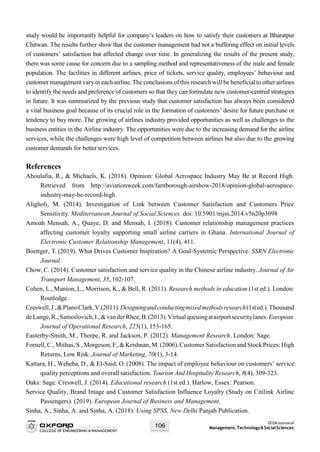
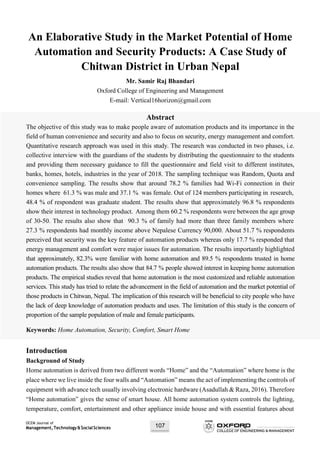
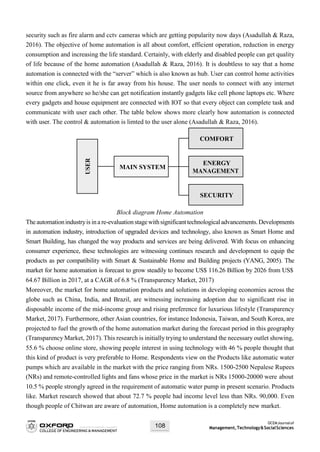





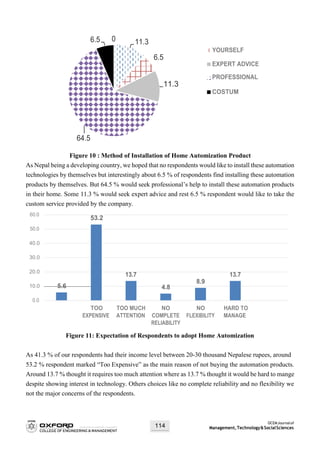


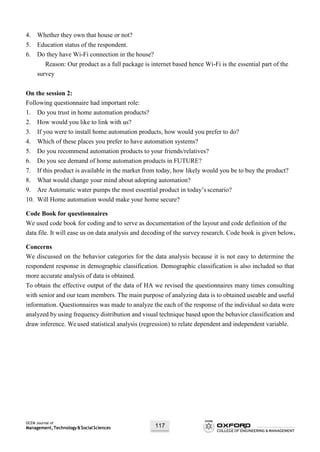

![OCEM Journal of
Management,Technology&SocialSciences 119
less than 5 %. The number of internet users has increased tenfold from 1999 to 2013 and reached first
billion in 2005, second billion in 2010 third billion in 2014 and penetration population of internet in the
world is 46.1% till July 1, 2016. As of, June 30, 2016 internet users in Asia is 49.5% with the highest
users and lowest user in Africa with 9.8 %. Similarly, In China Penetration population of internet user
is 52.2 %, in India 43 % and in Nepal 63 % (Internet Live Stats, 2019). A cross sectional descriptive
study was conducted to determine the prevalence of IA and contributor factors to determine internet
related behavior patterns among students of Science, using stratified random sampling method. Of 236
participants, 74.6% were females. The study revealed that 50.8 % had mild addiction, 40.7 % moderate
and 1.3 % had severe addiction. The finding of the study concluded that prevalence of IA is significantly
high (Adhikari B, 2015).
2. Literature Review
A cross-sectional school-based study was conducted in four cities in China among 13,723 students
(aged 12-20 years) to evaluate the associations between problematic Internet use and physical and
psychological symptoms. The Multidimensional Sub-health Questionnaire of, Pittsburgh Sleep
Quality Index and demographic variables were used to measure adolescents sleep quality, physical and
psychological symptoms respectively. Problematic internet use was assessed by the 20-item Young IA
Test. Prevalence rate of internet Addiction, physical symptoms, psychological symptoms, and poor sleep
quality were 11.7 %, 24.9 %, 19.8 %, and 26.7 %, respectively. Excessive internet use may not only
have direct adverse health consequences but also have indirect negative effects through sleep deprivation
(Van Ameringen, Simpson, Patterson, Turna & Khalesi, 2016). A cross-sectional survey was conducted
among 17,599 students in eight cities of China to test the relationship between Problematic internet use
and psychosomatic symptoms and life satisfaction among Adolescents. PIU was assessed by the 20-item
Young IA Test (YIAT). About 8.1 % of subjects showed PIU. Adolescents with PIU were associated
with males, high school students, urban, eastern and western areas, upper self-report family economy,
service type mostly used for entertainment and relieving loneliness and more frequency of internet use.
Compared with normal internet users, adolescents with PIU were more likely to suffer from psychosomatic
symptoms (P<0.001), including lack of physical energy (P<0.001), physiological disfunction (P<0.001),
weakened immunity (P<0.001), emotional symptoms (P<0.001), behavioral symptoms (P<0.001) and
social adaptation problems (P<0.001). Adolescents with PIU had lower scores on total and all dimensions
of life satisfaction (all P < 0.001) (Bozkurt, Özer, Şahin & Sönmezgöz, 2017).
Multistage sampling was conducted in the sampling procedure where student participants from Baguio
City were selected. The IA Test was used. Total of 1059 valid questionnaires were analyzed. Findings
suggest that adolescents are frequent online users and that there are significant differences in terms of
gender, school type, and online behaviors; social desirability had a strong positive relationship with
adolescent IA(Waldo, 2014). A survey was administered among 1097 adolescents aged between 11 and
18 years to explore the addictive symptomatology among British adolescents. A convenience sampling
technique was used. Only 71.8 % correctly completed all the Problematic Internet Entertainment Use
Scale for Adolescents [PIEUSA; PIEUSA items] (i.e. was., 1097 out of 1528 participants). The results
indicated that prevalence of online problem users was 5.290 and most of them were younger males that](https://image.slidesharecdn.com/finaljournal-201117003412/85/Dr-Basanta-Adhikari-119-320.jpg)



